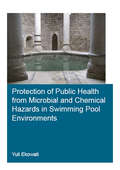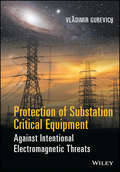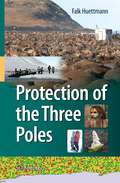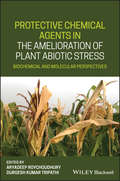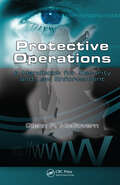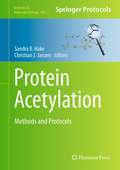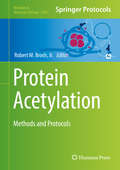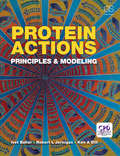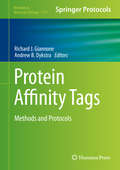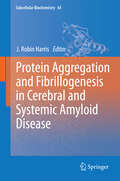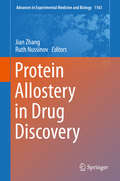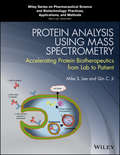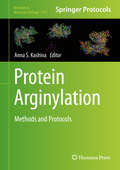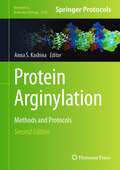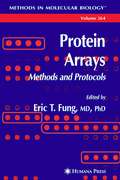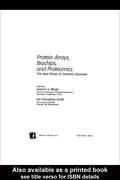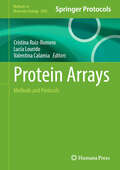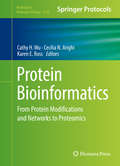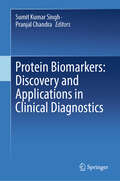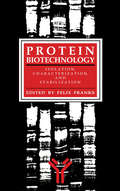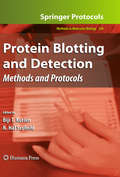- Table View
- List View
Protection of Modern Power Systems
by Janaka B. Ekanayake Vladimir Terzija Ajith Tennakoon Athula RajapakseProtection of Modern Power Systems Familiarize yourself with the cutting edge of power system protection technology All electrical systems are vulnerable to faults, whether produced by damaged equipment or the cumulative breakdown of insulation. Protection from these faults is therefore an essential part of electrical engineering, and the various forms of protection that have developed constitute a central component of any course of study related to power systems. Particularly in recent decades, however, the demands of decarbonization and reduced dependency on fossil fuels have driven innovation in the field of power systems. With new systems and paradigms come new kinds of faults and new protection needs, which promise to place power systems protection once again at the forefront of research and development. Protection of Modern Power Systems offers the first classroom-ready textbook to fully incorporate developments in renewable energy and ‘smart’ power systems into its overview of the field. It begins with a comprehensive guide to the principles of power system protection, before surveying the systems and equipment used in modern protection schemes, and finally discussing new and emerging protection paradigms. It promises to become the standard text in power system protection classrooms. Protection of Modern Power Systems readers will also find: Treatment of the new faults and protection paradigms produced by the introduction of new renewable generators Discussion of SmartGrids—intelligently-controlled active systems designed to integrate renewable energy into the power system—and their protection needs Detailed exploration of Synchronized Measurement Technology and Intelligent Electronic Devices Accompanying website to include Solutions Manual for instructors Protection of Modern Power Systems is an essential resource for students, researchers, and system engineers looking for a working knowledge of this critical subject.
Protection of Public Health from Microbial and Chemical Hazards in Swimming Pool Environments (IHE Delft PhD Thesis Series)
by Yuli EkowatiThis thesis describes the occurrence of microbial and chemical contaminants in swimming pools and the investigation of an alternative disinfection technology, UVOX Redox® that could reduce reliance on chlorine and the formation of chlorinated disinfection byproducts (DBPs) in swimming pools. This technology was effective in inactivation of chlorine resistant microorganisms, represented by Bacillus subtilis spores, and in combination with chlorine generated lower concentrations of chlorinated DBPs compared to chlorination alone. It enhanced the removal of pharmaceuticals and personal care products (PPCPs), which were frequently present in indoor, outdoor and spa pools. Carbamazepine and 1H-benzotriazole were the most frequently detected PPCPs, while hydrochlorothiazide and 4-methylbenzylidene camphor were detected at the highest concentration. An investigation of seven different swimming pool facilities showed that clinically relevant fungi were omnipresent. Floors at the sites where the pool visitors converge, such as the exit leading to shower rooms, showed the highest fungal concentrations. The distribution of fungi inside the swimming pool facilities highlighted potential transmission pathways and a possible risk of fungal infections. Future swimming pool water guidance should include raising awareness among swimmers, pool operators and managers about hygienic behaviour and better hygiene measures, and application of alternative disinfection technologies such as UVOX. Key features: Identifies clinically relevant fungi in swimming pool environments Identifies potential transmission pathways of clinically relevant fungi in indoor swimming pools Highlights the occurrence of PPCPs in different type of pools and their relation with pool water treatment Assesses an alternative disinfection technology for swimming pool water treatment.
Protection of Substation Critical Equipment Against Intentional Electromagnetic Threats
by Vladimir GurevichThe modern microprocessor based electronic equipment most vulnerable to Intentional Destructive Electromagnetic Interferences (IDEI) includes High-Altitude Electromagnetic Pulse (HEMP) in all substation equipment. However, power equipment and especially transformers are also subject to the influence of HEMP. The book discusses problems and solutions for both kinds of substation equipment. Separated into eight chapters, the book covers: Technological progress and its consequences; Intentional Destructive Electromagnetic Interferences (IDEI); Methods and means of Digital Protective Relay (DPR) protection from electromagnetic pulse; Passive methods and means of DPR protection from electromagnetic pulse; Active methods and means of DPR protection from electromagnetic pulse; Tests of DPR resistance to IDEI impacts; Organizational and technical measures to protect DPR from HEMP; and Protection of power equipment and transformers from HEMP. Key features: • Practical approach focusing on technical solutions for difficult problems. • Full data on electromagnetic threats and methods of their prevention are concentrated. • Addresses a gap in knowledge in the power system industry. This book emphasizes practical recommendations on protection of power substations' electric equipment from IDEI that intended for not only staff operating electric equipment, but also for manufacturers of this equipment, specialists of designing companies, managers of electric energy industry as well as for teachers and postgraduate students.
Protection of the Three Poles
by Falk HuettmannThe Arctic, the Antarctic, and the Hindu Kush-Himalayas form a trio of terrains sometimes called "the three poles". Mainly composed of rock, snow, and ice, these precious regions, which are home to many unique species such as the polar bear, the emperor penguin, and the snow leopard, contain the primary water resource of this planet and directly shape our climate. This book presents a first-ever global assessment and progressive review of the three poles and demonstrates the urgent need for their protection. Sins of the past have irrevocably harmed and threatened many of the unique qualities of these regions, and the future looks bleak with the global population forecast to reach 9 billion by 2060, and with climate change on the rise. Presented here is a wide-reaching and coherent overview of the three poles' biodiversity, habitats, and ongoing destruction. Failed protection and social targets set by the United Nations and other bodies are exposed while economic growth, unconstrained or inappropriate development, and urban sprawl are promoted unabated. Polar regions play a major role in the global agenda as they are rich in oil and other resources, marking them for contamination, overfishing, and further degradation. Tourism in the Antarctic has benefited from enlightened self-regulation, but there are signs that this is changing, too. The chapters of this book are written by experts in their fields, and their evidence leaves no doubt that we already live beyond our carrying capacity on a finite but decaying space. A global protection role model and several outlook scenarios are proposed to help set in motion polar protection priorities that are actually valid. Humanity has demonstrated through international treaties such as the Antarctic Treaty and the Madrid Protocol that we can put the interests of the planet as a whole first. This must become the norm, not the exception.
Protective Chemical Agents in the Amelioration of Plant Abiotic Stress: Biochemical and Molecular Perspectives
by Durgesh Kumar Tripathi Aryadeep RoychoudhuryA guide to the chemical agents that protect plants from various environmental stressors Protective Chemical Agents in the Amelioration of Plant Abiotic Stress offers a guide to the diverse chemical agents that have the potential to mitigate different forms of abiotic stresses in plants. Edited by two experts on the topic, the book explores the role of novel chemicals and shows how using such unique chemical agents can tackle the oxidative damages caused by environmental stresses. Exogenous application of different chemical agents or chemical priming of seeds presents opportunities for crop stress management. The use of chemical compounds as protective agents has been found to improve plant tolerance significantly in various crop and non-crop species against a range of different individually applied abiotic stresses by regulating the endogenous levels of the protective agents within plants. This important book: Explores the efficacy of various chemical agents to eliminate abiotic stress Offers a groundbreaking look at the topic and reviews the most recent advances in the field Includes information from noted authorities on the subject Promises to benefit agriculture under stress conditions at the ground level Written for researchers, academicians, and scientists, Protective Chemical Agents in the Amelioration of Plant Abiotic Stress details the wide range of protective chemical agents, their applications, and their intricate biochemical and molecular mechanism of action within the plant systems during adverse situations.
Protective Measurement and Quantum Reality
by Shan GaoProtective measurements offer an intriguing method for measuring the wave function of a single quantum system. With contributions from leading physicists and philosophers of physics - including two of the original discoverers of this important method - this book explores the concept of protective measurement, investigating its broad applications and deep implications. Addressing both physical and philosophical aspects, it covers a diverse range of topics, including experimental possibility of protective measurements, connections with the PBR theorem, and the implications of protective measurements for understanding the nature of quantum reality. Including a clear and concise introduction to standard quantum mechanics, conventional measurements, and the fundamentals of protective measurements, this is a valuable resource for graduate students and researchers interested in the conceptual foundations of quantum mechanics.
Protective Operations: A Handbook for Security and Law Enforcement
by Glenn McGovernA reference for law enforcement and security organizations tasked with protecting the welfare of an individual or groups of individuals, this volume offers suggestions and guidance for confronting high-threat scenarios as well as the more mundane protective details. Detailing the essence of protective operations that are run, in large part, covertly, the book explores operational security, situational awareness, and surveillance detection and includes examples from real-world attacks occurring over the past sixty years. Focusing on the economics of providing the most protection for the least cost, it also addresses issues surrounding possible direct violations of the law and department policy and procedures.
Protein Acetylation
by Christian J Janzen Sandra B HakeThousands of proteins have been identified to be acetylated. Immense research power has been dedicated to experiments to solve the biological implications of each and every protein acetylation. Two particular sites of protein acetylation have been described intensively: the N-terminal methionine residue of a nascent protein and lysine residues within a protein. In Protein Acetylation: Methods and Protocols, expert researchers in the field detail many of the methods which are now commonly used to study protein acetylation. These include methods and techniques for identification of protein acetylation, column- and gel electrophoresis-based approaches, computationally prediction, and the biological response to protein acetylation. Written in the highly successful Methods in Molecular BiologyTM series format, chapters include introductions to their respective topics, lists of the necessary materials and reagents, step-by-step, readily reproducible laboratory protocols, and key tips on troubleshooting and avoiding known pitfalls. Authoritative and practical, Protein Acetylation: Methods and Protocols seeks to aid scientists in the further study of the technical aspects involved in understanding protein acetylation.
Protein Acetylation: Methods and Protocols (Methods in Molecular Biology #1983)
by Robert M. Brosh Jr.The book focuses on the regulation of protein function and biological activity by the post-translational modification known as acetylation. Chapters detail a wide range of topics in protein acetylation dealing with pathways relevant to cellular homeostasis, gene expression, and DNA metabolism. Written in the highly successful Methods in Molecular Biology series format, chapters include introductions to their respective topics, lists of the necessary materials and reagents, step-by-step, readily reproducible laboratory protocols, and tips on troubleshooting and avoiding known pitfalls.Authoritative and cutting-edge, Protein Acetylation: Methods and Protocols aims to be an extremely valuable resource to novices and experts alike whose research takes them in the direction of characterizing regulatory switches in protein acetylation events, and how they are manifested in significant ways in diverse mechanisms biological systems.
Protein Actions: Principles and Modeling
by Ken Dill Robert L. Jernigan Ivet BaharProtein Actions: Principles and Modeling is aimed at graduates, advanced undergraduates, and any professional who seeks an introduction to the biological, chemical, and physical properties of proteins. Broadly accessible to biophysicists and biochemists, it will be particularly useful to student and professional structural biologists and molecular biophysicists, bioinformaticians and computational biologists, biological chemists (particularly drug designers) and molecular bioengineers. The book begins by introducing the basic principles of protein structure and function. Some readers will be familiar with aspects of this, but the authors build up a more quantitative approach than their competitors. Emphasizing concepts and theory rather than experimental techniques, the book shows how proteins can be analyzed using the disciplines of elementary statistical mechanics, energetics, and kinetics. These chapters illuminate how proteins attain biologically active states and the properties of those states. The book ends with a synopsis the roles of computational biology and bioinformatics in protein science.
Protein Affinity Tags
by Richard J. Giannone Andrew B. DykstraProtein Affinity Tags: Methods and Protocols provides researchers with the necessary information, tools, and strategy required for proper inquiry into a given protein's function and structure. Today's researchers can easily alter the amino acid sequence of any given protein, a powerful technology allowing for the precise engineering of specific proteins. Protein affinity tagging employs the use of known protein binding interactions in order to "fish out" a protein-of-interest or, with more advanced tags, a protein complex. This technology paired with recent advancements in DNA sequencing technology promises a future that is awash with novel genomic information - information that will not only expand our knowledge of the processes that govern life, but also fuel innovation that will undoubtedly conquer many of today's most salient health and environmental challenges. Written in the successful Methods in Molecular Biology series format, chapters include introductions to their respective topics, lists of the necessary materials and reagents, step-by-step, readily reproducible protocols, and notes on troubleshooting and avoiding known pitfalls. Authoritative and easily accessible, Protein Affinity Tags: Methods and Protocols will be an invaluable resource to those seeking to employ protein affinity tags to study their biological system of interest.
Protein Aggregation and Fibrillogenesis in Cerebral and Systemic Amyloid Disease (Subcellular Biochemistry #65)
by J. Robin HarrisThis volume of the Subcellular Biochemistry series is the result of the long-standing research interest of the editor in the molecular mechanism underlying Alzheimer's disease and other amyloid diseases, indicated also by the earlier book in the series (Volume 38), devoted to Alzheimer's disease. The broad coverage within the present amyloidogenesis book represents an attempt to collate current knowledge relating to the proteins and peptides involved in most of the known amyloid diseases, together with some amyloid/fibril-forming proteins and peptides that are not involved in diseases. Thus, the range of topics included is comprehensive and furthermore it was thought appropriate to include both basic science and clinical presentation of the subjects under discussion.
Protein Aggregation: Methods and Protocols (Methods in Molecular Biology #2551)
by Andrzej Stanisław CieplakThe volume details techniques, methods, and conceptual developments to further the study of protein aggregation with emphasis on the pleiomorphic proteins implicated in etiology of neurodegeneration. Chapters guide readers through in vitro and in vivo studies of fibrillization and liquid-liquid phase separation processes, and offer a comprehensive account of the state-of-art of structural studies of protein aggregation. Written in the format of the highly successful Methods in Molecular Biology series, each chapter includes an introduction to the topic, lists necessary materials and reagents, includes tips on troubleshooting and known pitfalls, and step-by-step, readily reproducible protocols. Authoritative and cutting-edge, Protein Aggregation: Methods and Protocols aims to be useful and practical guide to new researchers and experts looking to expand their knowledge.
Protein Allostery in Drug Discovery (Advances in Experimental Medicine and Biology #1163)
by Ruth Nussinov Jian ZhangThe book focuses on protein allostery in drug discovery. Allosteric regulation, ʹthe second secret of lifeʹ, fine-tunes virtually most biological processes and controls physiological activities. Allostery can both cause human diseases and contribute to development of new therapeutics. Allosteric drugs exhibit unparalleled advantages compared to conventional orthosteric drugs, rendering the development of allosteric modulators as an appealing strategy to improve selectivity and pharmacodynamic properties in drug leads. The Series delineates the immense significance of protein allostery—as demonstrated by recent advances in the repertoires of the concept, its mechanistic mechanisms, and networks, characteristics of allosteric proteins, modulators, and sites, development of computational and experimental methods to predict allosteric sites, small-molecule allosteric modulators of protein kinases and G-protein coupled receptors, engineering allostery, and the underlying role of allostery in precise medicine. Comprehensive understanding of protein allostery is expected to guide the rational design of allosteric drugs for the treatment of human diseases. The book would be useful for scientists and students in the field of protein science and Pharmacology etc.
Protein Analysis using Mass Spectrometry: Accelerating Protein Biotherapeutics from Lab to Patient
by Mike S. Lee Qin C. JiPresents Practical Applications of Mass Spectrometry for Protein Analysis and Covers Their Impact on Accelerating Drug Discovery and Development Covers both qualitative and quantitative aspects of Mass Spectrometry protein analysis in drug discovery Principles, Instrumentation, Technologies topics include MS of peptides, proteins, and ADCs , instrumentation in protein analysis, nanospray technology in MS protein analysis, and automation in MS protein analysis Details emerging areas from drug monitoring to patient care such as Identification and validation of biomarkers for cancer, targeted MS approaches for biomarker validation, biomarker discovery, and regulatory perspectives Brings together the most current advances in the mass spectrometry technology and related method in protein analysis
Protein Arginylation
by Anna S. KashinaThis volume presents a comprehensive overview of all the existing methods on analysing protein arginylation, from the early methods utilizing crude protein preparations and whole-cell assays to the latest advanced methods involving recombinant protein techniques, antibodies, high precision mass spectrometry, and chemical probes. This book also includes essays from the founders of the field, who originally discovered arginylation in the early 1960s and brought it to international recognition. Written in the highly successful Methods in Molecular Biology series format, chapters include introductions to their respective topics, lists of the necessary materials and reagents, step-by-step, readily reproducible laboratory protocols, and tips on troubleshooting and avoiding known pitfalls. Cutting-edge and thorough, Protein Arginylation: Methods and Protocols would interest the emerging body of scientists involved in the studies of posttranslational arginylation and the rapidly growing community of researchers working on a broad range of posttranslational modifications, the analysis of which often meets similar challenges and utilizes similar principles as posttranslational arginylation.
Protein Arginylation: Methods and Protocols (Methods in Molecular Biology #2620)
by Anna S. KashinaThis second edition provides updated and new chapters that detail comprehensive overview of all the existing methods on analyzing protein arginylation. Chapters guide readers through the early methods utilizing crude protein preparations and whole-cell assays to the latest advanced methods involving recombinant protein techniques, antibodies, high precision mass spectrometry, and chemical probes. Written in the format of the highly successful Methods in Molecular Biology series, each chapter includes an introduction to the topic, lists necessary materials and methods, includes tips on troubleshooting and known pitfalls, and step-by-step, readily reproducible protocols. Cutting-edge and thorough, Protein Arginylation: Methods and Protocols, Second Edition aims to be of interest to novice researchers involved in posttranslational arginylation research and researchers working on a broad range of posttranslational modifications.
Protein Arrays
by Eric FungA diverse collection of unique methodologies to synthesize and construct protein arrays for basic and clinical research in a high-throughput manner. These readily reproducible techniques can be applied to such applications as quantifying specific proteins of interest and discovering novel proteins, as well as to a variety of affinity substances, including antibodies, peptides, proteins, aptamers, and chemicals. The techniques can be used for biomarkers discovery, assay development, clinical sample testing, and building the next generation of molecular tools.
Protein Arrays, Biochips and Proteomics: The Next Phase of Genomic Discovery
by Joanna S. Albala Ion Humphery-SmithFrom disease marker identification to accelerated drug development, Protein Arrays, Biochips, and Proteomics offers a detailed overview of current and emerging trends in the field of array-based proteomics. This reference focuses on innovations in protein microarrays and biochips, mass spectrometry, high-throughput protein expression, protein-prote
Protein Arrays: Methods and Protocols (Methods in Molecular Biology #2929)
by Cristina Ruiz-Romero Lucía Lourido Valentina CalamiaThis volume discusses the latest methods and applications of protein microarrays and helps researchers harness its power in their work. The chapters in this book explore protein microarray&’s development and fabrication, strategies for their data analysis, and wide-reaching applications in biology and disease research. Written in the highly successful Methods in Molecular Biology series format, chapters include introductions to their respective topics, lists of the necessary materials and reagents, step-by-step, readily reproducible laboratory protocols, and tips on troubleshooting and avoiding known pitfalls.Cutting-edge and thorough, Protein Arrays: Methods and Protocols is a valuable resource for graduate students, postdoctoral researchers, laboratory scientists, and industry professionals who wish to learn more about protein microarray technology.Chapter 3 is available open access under a Creative Commons Attribution 4.0 International License via link.springer.com.
Protein Bioinformatics (Methods in Molecular Biology #2836)
by Frédérique LisacekThis detailed volume explores techniques for protein bioinformatics research, including databases, software tools, and computational methods, in the context of protein science or proteomics and opening to other omics areas. Beginning with a section on proteogenomics, the book continues by covering posttranslational modifications, processing large-scale mass spectrometry data, protein structure and interactions, as well as protein feature inference. Written for the highly successful Methods in Molecular Biology series, chapters include the kind of detailed implementation advice to ensure efficacious results. Authoritative and practical, Protein Bioinformatics serves as an ideal guide for researchers in disciplines encompassing the biotechnological, pharmaceutical, biological, and medical sciences, as well as the computational and engineering sciences.
Protein Bioinformatics: From Protein Modifications and Networks to Proteomics (Methods in Molecular Biology #1558)
by Cathy H. Wu Cecilia N. Arighi Karen E. RossThis volume introduces bioinformatics research methods for proteins, with special focus on protein post-translational modifications (PTMs) and networks. This book is organized into four parts and covers the basic framework and major resources for analysis of protein sequence, structure, and function; approaches and resources for analysis of protein PTMs, protein-protein interactions (PPIs) and protein networks, including tools for PPI prediction and approaches for the construction of PPI and PTM networks; and bioinformatics approaches in proteomics, including computational methods for mass spectrometry-based proteomics and integrative analysis for alternative splice isoforms, for functional discovery. Written in the highly successful Methods in Molecular Biology series format, chapters include introductions to their respective topics, lists of the necessary materials and reagents, step-by-step, readily reproducible laboratory or computational protocols, and tips on troubleshooting and avoiding known pitfalls.Cutting-edge and thorough, Protein Bioinformatics: From Protein Modifications and Networks to Proteomics is a valuable resource for readers who wish to learn about state-of-the-art bioinformatics databases and tools, novel computational methods, and future trends in protein and proteomic data analysis in systems biology. This book is useful to researchers who work in the biotechnology and pharmaceutical industries, and in various academic departments, such as biological and medical sciences and computer sciences and engineering.
Protein Biomarkers: Discovery and Applications in Clinical Diagnostics
by Pranjal Chandra Sumit Kumar SinghThis book comprehensively reviews the fundamentals of biomarker discovery using mass-spectrometry-based proteomic and glycoproteomic methods. It also provides case studies of proteomic and glycoproteomic molecular signatures to illustrate the design and use of various mass spectrometry modes such as selected reaction monitoring (SRM), parallel reaction monitoring (PRM), and sequential window acquisition of all theoretical fragment ion spectra mass spectrometry (SWATH-MS). In turn, the book presents the challenges of the proteomic methods in biomarker discovery and approaches for overcoming these challenges by extending the performance by improving the sensitivity, throughput, and selectivity of the method. It also addresses the bottleneck of deriving useful biological interpretations from large multi-dimensional datasets emanating from these experiments by discussing data analysis pipelines and appropriate statistical analysis. Finally, a detailed discussion on the design, characterization, and application of protein/glycoprotein-based biosensors for clinical diagnostics is discussed. The book is intended to serve as a reliable resource for the students and researchers working in the area of biomarker discovery and validation using mass spectrometry-based methods and their subsequent applications for biosensor design.
Protein Biotechnology
by Felix FranksFelix Franks' new volume, Protein Biotechnology, is a comprehensive compendium of state-of-the-art techniques for isolating, purifying, characterizing, and analyzing proteins as commercial products, both in vitro and in vivo. The book also highlights leading-edge analytical methods used throughout biotechnology today, especially in quality control, and contains a wealth of economic and technical information. The book's particular strength lies in its emphasis on proteins as commercial products, not merely experimental laboratory entities. Topics treated include: description and classification of proteins * economics and technology of characterization * analytical chromatography of amino acids, peptides, and proteins * structure, organization, and function * posttranslational processing * fragmentation * peptide sequence determination * electrophoretic techniques * polyclonal and monoclonal antibodies * conformational stability * protein hydration * recombinant protein technology * storage stabilization * process purification. An essential tool for everyone who needs to stay effective in today's highly competitive biotechnology arena.
Protein Blotting and Detection
by Biji T. Kurien R. Hal ScofieldOver the past thirty years, the development of the Western blot has revolutionized the fields of biomedical research and medical diagnostics. In "Protein Blotting and Detection: Methods and Protocols", expert researchers present numerous techniques based on the Western blot, providing detailed, readily reproducible methods, tips, and alternatives directly and easily transferable to the laboratory setting. Chapters offer a large number of variations on the theme of protein transfer to solid support followed by detection, presenting both adaptations of traditional techniques as well as completely original methods of protein blotting. Composed in the highly successful Methods in Molecular BiologyTM series format, each chapter contains a brief introduction, a list of necessary materials, step-by-step methods, and a Notes section which shares tips on troubleshooting and avoiding known pitfalls. Innovative and highly practical, Protein Blotting and Detection: Methods and Protocols is an essential, hands-on guide for all investigators who hope to bring these cutting-edge procedures home to their laboratories.

